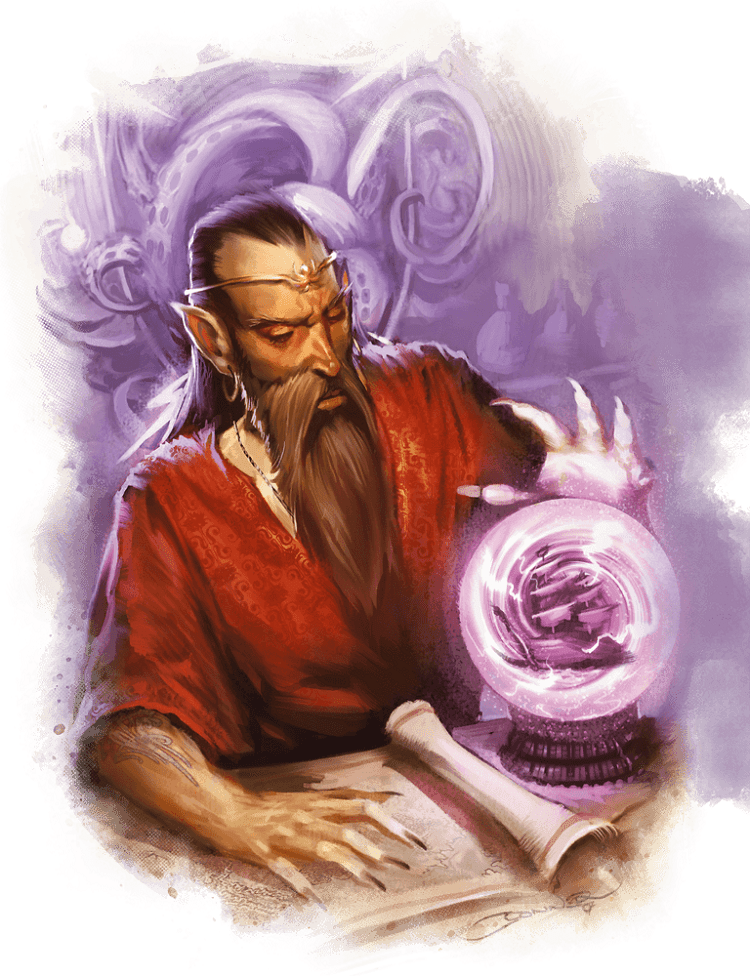Your party is in a dungeon with multiple exits and many missions to accomplish. You have the double task of reaching further into the dungeon and finding the Artifact, but no creature can escape. Thankfully, you can coordinate everything while walking along the halls. That is the power of teamwork.
The inquisitor is in front of his prisoner, tied up on a chair. His companion is playing the “good cop,” talking about how good would it be for him if everything went smoothly.
Meanwhile, the inquisitor is telling things straight to his mind, and for every good word the “good cop” says, he warns him of the consequences. Hopefully, this last one won’t pee his pants.
The king invited you to a party, and the waitresses brought everyone in sight food and drink. You spot the love of your life just beside his hideous father.
You can’t get near him, so you start to whisper in his ear all the things you want to do together. However, no one can hear you, and you plan your subsequent encounter without anyone realizing that you’ve been talking the entire evening.
These, and many more things, are achieved with just one trick. Welcome to a Message 5e Guide.
The Importance of Communication
“Message” is a cantrip with some profound implications. It’s the little brother of “Sending” (Check out our Complete Sending 5e Guide) and the cheapest way of pseudo-telepathy in the game.
When we think of communication in the real world, sometimes we forget how hard it was to communicate in the Middle Ages and how much the world has changed because of technology.
This spell is essentially the lavalier microphone used in TV inside the studio. Think of how much this technology is used nowadays for coordination and communication efficiency. Leaders, spies, managers, entertainers, and many others have an excellent reason to learn this cantrip. But how about adventurers? Let’s see.
How does “Message” Work?

“Message” is a cantrip or 0-level spell. The casting time is one action, the range is 120 feet, the components are verbal, somatic, and material, and the duration is 1 round. Lastly, the school is transmutation. The effect is as follows:
“You point your finger toward a creature within range and whisper a message. The target (and only the target) hears the message and can reply in a whisper that only you can hear.
You can cast this spell through solid objects if you are familiar with the target and know it is beyond the barrier. Magical Silence, 1 foot of stone, 1 inch of common metal, a thin sheet of lead, or 3 feet of wood blocks the spell. The spell doesn’t have to follow a straight line and can travel freely around corners or through openings.”
Breaking Down the Spell
“Message” is a cantrip. This means a lot about how to think about this spell. It’s good to compare it with the 3rd level spell “Sending.” Think of “Message” as a walkie-talkie and “Sending” as one of the first landlines that were used. The first is used a lot in many situations as a day-to-day tool.
The latter is a one-of-a-time, situational spell. In other words, use Message all the time, it doesn’t use a spell slot, and it’s ingrained in your character.
The standard one action to cast is pretty self-explanatory, but it comes with consideration for combat. You use your action if you want to use the spell to communicate something in battle.
This is important if you are in a situation where you need some information to be delivered fast. One action means 6 seconds where you can’t do something else (unless it is a movement or a bonus action, of course).
The range of 120 ft is potent for a cantrip. The spell is excellent outside combat, for communicating inside a location, like a castle or a dungeon. The range is also beneficial against melee foes.
Most humanoids can’t get in melee in a round when they are 120 feet away. “Message” is not for combat, but most casters don’t want to be in harm’s way in those fringe situations where it can be used.
Components are limitations, and “Message” has the three of them. This is a big problem and a hint at how powerful the spell is. Always keep in mind the components because they make the spell unable to cast if they are not met.
In this case, being silenced (in any manner), unable to use your hands, or without the material component/spellcasting focus renders the spell useless.
The duration is also highly restrictive, but it’s understandable for a cantrip. It’s needed to be cast multiple times to communicate regularly with someone. The spell is called “message,” after all.
You have just a few seconds to get your message across. The only unclear part is if the receiver’s response has to happen under that same round, but we’ll discuss it later.
The effect is self-explanatory, but there are some things to remember. The spell states many restrictions besides the components that need to be considered if you want the spell to be used properly.
The spell is crystal clear on your character’s action to cast, so that’s also a limitation. But we’ll discuss this further and the DM’s role with this spell.
School of Transmutation, what does it Mean?
Some spells have an evident power and, thus, a clean categorization. Things like Fireball in the Evocation School or Augury in the Divination School are clear-cut.
But when it comes to “Message,” its school of magic helps us understand the essence of the magic in play (or at least, the writers’ intention). This, in turn, enables us to determine as DMs (and argue as players) how to adjudicate some gray areas of the spell.
“Message” is a Transmutation cantrip. In other words, manipulation of matter itself and not some creation or enchantment. The spell doesn’t affect the mind. It involves the medium of communication, the sound.
An example of the consequences of the school is this Tweet of Jeremy Crawford that says: “The message spell isn’t telepathy. The caster literally whispers a message that the target hears if able.”
These are the soft rules of the game. They help us think like gamers in terms of rules and their applications. Nonetheless, they are soft rules, so it’s still a matter of interpretation.
Who Can be the “Messenger”?

The “Message” cantrip is available in the Artificer, Bard, Sorcerer, and Wizard spell lists. But this being a cantrip means that ANY character could use it at the fourth level with the “Magic Initiate” or “Artificer Initiate” feat.
Also, High Elves and Half-Elves can grab it. You can also get this spell if your subclass has access to those spell lists: Arcane Tricksters, Eldritch Knights, and Arcana Domain Clerics, for example. Warlocks with Pact of the Tome can learn it too.
DMs could also use this cantrip in almost any NPC they see fit. However, here is a small list of some of the creatures that have it:
- Monsters: Derro Savant, Blue Abishai, Drow Favored Consort, Drow Inquisitor, Githyanki Gish, Nagpa, Yuan-ti Mind Whisperer, Yuan-ti Nightmare Speaker, Yuan-ti Pit Master
- NPCs: Abjurer, Diviner, and Enchanter
Is there any Space for Creativity with Message?
There is always room for creativity, especially if your DM is loose with the rules. “Message” is not such an open-ended cantrip as Minor Illusion or Prestidigitation (, but it’s not as clear-cut as Fire Bolt.
Related reads:
It has applications that go further than just a message. Perhaps creativity isn’t the right word. To use this cantrip, you need ingenuity.
You can find many funny moments where somebody used this cantrip on the internet, and I also have some moments to share. Many spell interactions need DM approval because they don’t follow the rules as written, and others land on Homebrew territory.
But I like categorization, and in this case, most times I’ve seen alternative uses for this cantrip are one of these ways:
- To enable some sound-based mechanic: This is the case of something like Bardic Inspiration, where you could grant this beyond its normal reach and even through objects. Or there was a time when I fought some sort of screaming demon, and I tried to bargain with a Message. The creature replied with a scream that forced me to do a Wisdom Save.
- To intimidate/confuse an unwilling creature: This is when you follow someone and send them a whisper, causing some severe paranoia—or interrogating a prisoner but avoiding others from hearing what you’re saying. Combine “Message” with the “actor” feat, and you could even fool someone that you’re another person, like a loved one.
- To misinform people: Picture yourself as a double agent, going on a mission with one of your enemies and coordinating the assault. You tell one they need to go left, the other right, and the last one to go up. You just divided your enemies. Like this, there are many opportunities to tell wrong information using this spell to get around other ears.
You can use this cantrip in many other situations, and you need to be open-minded about the power of secrecy and communication.
So, do I Take it or not?

“Message” is a good cantrip, probably one of my top 10 choices. Nonetheless, it’s not a Must-Have in any campaign. There is always the possibility of being in a campaign where combat is the most critical part of all, and there won’t be many exploration or social encounters to use this spell at its best.
You’ll probably have many instances where this cantrip would be unusable or unnecessary.
It’s also good to point at all its limitations. It has all three components, which makes it a big problem if the enemy has some ability to cancel your movement or if you’re in a situation where you can’t speak or move.
If you get stuck in a spider’s web and can’t move, you wouldn’t be able to call your teammates for help. Also, RAW the spell specifies that you “point a finger at a target,” so even if you don’t need the somatic component, you still need to point at the target.
There is also the spell’s duration, which can make for an unnecessary discussion about the time one has to respond to the caster. In everyday communication, you sometimes need to think a bit before answering, and if you only have 6 seconds for the spell to be used, it’s probably not enough.
In many of these situations, we come to one of the golden rules of DND: Talk to your DM/players. Make it as straightforward as possible how you want the spell to work, the flavor you want to give it, and the situations you want to use it and how.
Everybody needs to be on the same page from the beginning to avoid unnecessary fighting.
Flavor, the Character, and their Personality

Sometimes we have a character in mind that would benefit from a cantrip like “Message,” but you’re not sure if it fits. We’ve seen the power of the cantrip and the plethora of moments where it may come in handy. But is it suitable for my character?
Flavoring a spell to fit your character is as important as the power itself. It is more than just a tool; it’s yours. Give it a personality. Maybe you talk to a piece of metal with the form of an ear, or your whispers shimmer as they go mute.
It’s magic, and it can be the bread and butter of your character if you create around that sort of quirk.
Maybe the campaign is not the best for this cantrip, but your character is, and that could be enough. It’s good to keep in mind that if something you like is not fit for the campaign, you have two options: You can talk to your DM and see if the cantrip could be helpful, or you can pick another character and leave the first for another campaign.
Playing with a suboptimal character can be fun for some, but I don’t recommend it, especially if the rest of the party is more equipped.
Message 5e Guide: FAQs
Question: Is the Whisper the Verbal Component of “Message”?
Answer: No, they are two separate things. For how the rules for spells work, first, the character spells a verbal incantation like “hocus-pocus” (just to put an example), and then the effect would activate.
This means you first cast the spell, and then you say your message. The rule is to avoid using a spell in public without anyone noticing. You can avert this with something like “subtle spell.”
Question: Can You Cast “Message” in Silence?
Answer: The short answer is no. You need to speak the verbal component of the spell. However, a couple of things to consider when we say “silence.” If you are in a magical silenced space, you can’t use any verbal component.
If you are thinking of using a verbal component in a low voice, then it is up to the DM how loud a caster should speak to affect the Weave. In other words, the volume of the caster’s speech is up for interpretation but not the fact that they need to get sound out of their mouth to do magic.
Lastly, if you can ignore the verbal component, you can cast the spell even under magical silence. That is the case for the Subtle Spell Metamagic.
Question: Does “Message” Work on Animals?
Answer: You can target any creature with this spell, including animals. However, if the animal can understand you or not depends on whether the animal would understand you anyway if you spoke normally.
You can give a command to your pet as usual with the spell, but if you do that with a wild animal, it will react as if you were talking to it normally, probably fleeing.
In Conclusion, how do I Respond to this Message?
“Message” is an excellent cantrip. It’s practical, funny, crucial sometimes, and even world-changing with the appropriate world-building.
Using it during the campaign is almost assured, but how powerful it can be depends on the adventure, the DM ruling, and your own ingenuity. Go ahead and pick this cantrip if it’s suitable for your character, and have fun at your table as the magical whisperer.
- Shadow Blade 5e Guide: The Edgy Sword - October 31, 2022
- Aid 5e Guide: Free Points! - October 1, 2022
- Flaming Sphere 5e Guide: Running Orb of Fiery Chaos: - October 1, 2022

